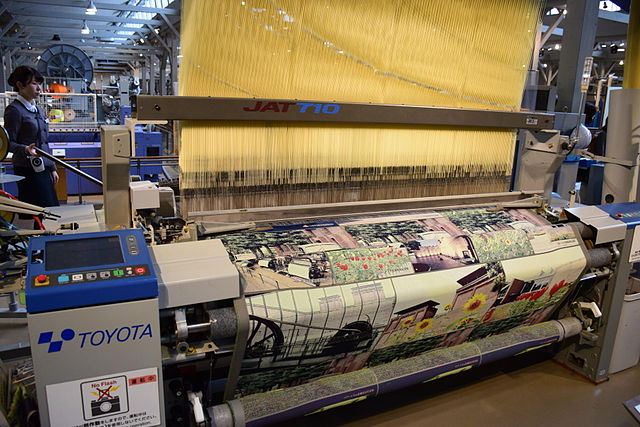Previously on Sekai Ichi, I took a detour to bring back some memories of my first-ever trip to Japan. In addition to Nagoya Castle, our tour guide took us to one of the city's sites involving Toyota, the largest car manufacturer in Japan, and second-largest in the world, behind the Volkswagen group. In particular, we visited the Toyota Commemorative Museum of Industry and Technology (トヨタ産業技術記念館, Toyota Sangyō Gijutsu Kinenkan), sometimes called the "Toyota Techno Museum" (トヨタテクノミュージアム, Toyota Tekuno Myūjiamu) for short.
 |
| By Morio [GFDL or CC-BY-SA-3.0], from Wikimedia Commons |
 |
| By Bariston [CC BY-SA 4.0], from Wikimedia Commons |
From the Textile Machinery Pavilion, the next stop for visitors is the Automotive Pavilion. There is a small collection of Toyota cars on display, spanning their history from the 1930s to today. Exhibits along the far side of the hall go into workings and evolution of car components and the assembly line process. There's even a continually-running short film (subtitled in Japanese, English, and Chinese) that shows the assembly process. For those who cannot make it onto a Toyota factory tour (described below), this makes for a convenient alternative.
 |
| By Mytho88 [GFDL or CC BY-SA 3.0], from Wikimedia Commons |
Also in the above picture, you can see an old logo with the name "Toyoda", as opposed to "Toyota". One of the things we learned on the tour was the evolution of the company's name. It started off as "Toyoda", written in katakana as "トヨダ", after the name of its founding family. Not long after, this name was changed to "Toyota", or "トヨタ". Among the reasons are that it is simpler to write, sounds clearer, and is written with 8 strokes instead of 10, 8 being a lucky number in Sino-Japanese culture.
They also had this concept vehicle on display. Basically, it's just a seat on wheels. You could take turns sitting in it, too. I can't remember if I got on it, but if it ever makes it into production, I'm certain it would be interesting to drive!
From the exit of the Automotive Pavillion, we were greeted by the Toyota Partner Robot, which gave a little musical performance. I believe it enthralled my grandmother the most out of everything on our trip!
Finally, there is the "Technoland", an area with kid-friendly, hands-on exhibits to help reinforce the concepts taught elsewhere in the museum.
The Toyota Techno Museum may have been the only Toyota-related place we visited before moving on to Inuyama, but there are other places around the city that will interest car fans. The Toyota Kaikan Museum is an exhibition hall of new car models, and also the starting point for tours of the factory. (Open 9:30 AM to 5:00 PM, free, tours require free pre-registration.) Elsewhere, the Toyota Automobile Museum is a collection of cars from Japan, the US, and Europe, spanning over a century of history. (Open 9:30 AM to 5:00 PM, closed Mondays, entry ¥1,000.)
Well, that's all I have for Nagoya. My 2010 self ventured on to the nearby town of Inuyama, where I experienced my first kimono dressing and tea ceremony, and climbed up the more authentically-preserved Inuyama Castle. Unfortunately, our camera's batteries ran out by then, so I don't have any pictures from there. As for my 2016 self, I continued on to Osaka and set up at my next hotel there. But, I may meet up with my past self again in Kyoto...!
Hours: Open from 9:30 AM to 5:00 PM. Admission ends 30 minutes before closing time. Closed on Mondays and New Year's Day.
Costs: ¥500. Audio guides in multiple languages (Japanese, English, Chinese, and Korean) can be downloaded as free apps for iPhone and Android devices. More information: (App Store) (Google Play)
Address: 4-1-35 Noritake Shinmachi, Nishi-ku, Nagoya-shi, Aichi-ken 〒451-0051
Access: From Nagoya Station, take the Meitetsu Nagoya (NH) line to Sako (NH37, 2 minutes, ¥170). You can also take the Me~guru loop bus to the museum (8 minutes, ¥210), or you can walk from Nagoya Station to the museum in about 20 minutes.
Directions: From Sako Station, cross at the intersection and turn right onto Meieki-dori. The museum will be on the left side, before the next traffic light.
From Nagoya Station, exit via the Sakura-dori Exit and turn left onto Meieki-dori. Continue straight ahead for 20 minutes. The museum will be on the right side, after the 4th traffic light.
Website: (English) (Japanese)
Access: From Nagoya Station, take the Meitetsu Nagoya (NH) line to Sako (NH37, 2 minutes, ¥170). You can also take the Me~guru loop bus to the museum (8 minutes, ¥210), or you can walk from Nagoya Station to the museum in about 20 minutes.
Directions: From Sako Station, cross at the intersection and turn right onto Meieki-dori. The museum will be on the left side, before the next traffic light.
From Nagoya Station, exit via the Sakura-dori Exit and turn left onto Meieki-dori. Continue straight ahead for 20 minutes. The museum will be on the right side, after the 4th traffic light.
Website: (English) (Japanese)
[1] "Information from a sign at the Toyota Museum in Nagakute-cho, Aichi-gun, Aichi Pref". Toyota. Archived from the original on November 20, 2012.






